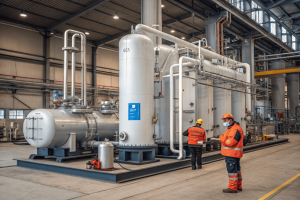What are the key advantages of post-combustion CO₂ capture?
•
What are the key advantages of post-combustion CO₂ capture?
You need to cut emissions from your existing plant. A total rebuild is impossible. You need a practical solution that integrates with your current operations without massive disruption or risk.
The key advantages are its flexibility to retrofit existing facilities, its use of mature and proven technologies like amine scrubbing, and its minimal interference with the main combustion or production process. It treats emissions at the end of the pipe.
I work with plants that have been operating for decades. Their owners can't just tear them down. They need a solution that bolts onto their existing infrastructure. This is where post-combustion capture really shines. It allows them to meet new environmental goals while keeping their core business running. Let's explore why this approach is so practical and widely adopted across so many industries.
Why is post-combustion capture suitable for retrofitting existing power plants?
You have a power plant with years of operational life left. Shutting it down isn't an option, but you must meet new emission targets. How can you decarbonize without starting from scratch?
Post-combustion capture is ideal for retrofitting because it's an "end-of-pipe" system. It connects to the exhaust flue and treats the gas after combustion, requiring minimal changes to the existing boiler, furnace, or turbines. This significantly reduces cost and downtime.

The term "end-of-pipe" is key here. Think of it like adding a filter to your home's water main instead of replacing all the pipes. The core function—generating power—remains largely untouched. The existing boilers, turbines, and generators continue to operate as they always have. We simply divert the flue gas after it has done its job but before it enters the atmosphere. This modular approach is what makes it the go-to solution for facilities that are already built and operating.
Minimal Operational Interference
The beauty of this approach lies in its separation from the primary process. The carbon capture plant is essentially a separate chemical processing unit that is integrated at the very end. This means the power plant can continue to generate electricity during the construction of the capture facility. The final tie-in requires a planned shutdown, but it is far shorter and less complex than a complete plant overhaul. This de-risks the project significantly because the plant’s main revenue-generating activities are not fundamentally altered.
Preserving Asset Value
By retrofitting, companies can extend the life of multi-billion dollar assets while bringing them into environmental compliance. It avoids the massive capital expenditure and long lead times associated with building a new plant from the ground up, such as a pre-combustion IGCC facility.
| Factor | Retrofit (Post-Combustion) | New Build (e.g., Pre-Combustion) |
|---|---|---|
| Capital Cost | Lower (adds to existing asset) | Extremely high (entire new facility) |
| Project Timeline | Shorter | Much longer (design, permit, build from scratch) |
| Operational Risk | Lower (core process is known and reliable) | Higher (integrates new, complex processes) |
| Impact on Core Asset | Minimal changes required | Requires a complete system replacement |
What are the most mature technologies used in post-combustion capture (e.g., amine scrubbing)?
You need a reliable, proven technology for your capture project. You can't afford to experiment with unproven methods. You need a system with a long track record of performance and predictable operational costs.
The most mature and widely used technology for post-combustion capture is solvent-based absorption, specifically using amine scrubbing. This chemical process has been reliably used for decades in industrial gas purification and is well-understood.
When clients ask me for the most dependable option, I almost always start with amine scrubbing. It’s the industry’s workhorse for a reason. This isn't a new-fangled lab experiment; it's a technology that has been used for over 70 years in the natural gas industry to remove acid gases like H₂S and CO₂. We have decades of operational data, a mature supply chain for both the equipment and the solvents, and a deep understanding of how to optimize the process for efficiency and reliability.
The Amine Scrubbing Process Explained
This technology is a continuous, regenerative chemical loop. It's an elegant solution to a complex chemical separation problem.
The Absorber and Stripper
The process works with two main columns. First, the flue gas is cooled and then bubbled up through an absorber tower. In this tower, it comes into contact with a cool, lean amine solvent. The amine has a chemical affinity for CO₂ and selectively absorbs it, letting the nitrogen and other gases pass through to the stack. Second, the now "rich" amine, loaded with CO₂, is pumped to a second column called the stripper. Here, heat (usually in the form of low-pressure steam) is applied. The heat breaks the chemical bond, releasing the CO₂ as a nearly pure gas stream ready for compression. The now "lean" amine is cooled and recycled back to the absorber to capture more CO₂, completing the loop.
This cycle is incredibly effective, capable of capturing over 90% of the CO₂ from a flue gas stream. While a significant amount of energy is needed in the stripper to regenerate the solvent—known as the "energy penalty"—it remains the most economically viable and lowest-risk technology for large-scale applications today.
How does the flexibility of post-combustion capture benefit various industries?
Your facility isn't a power plant. You work in cement, steel, or chemical manufacturing, and you need to know if this technology can be adapted to your specific process and flue gas composition.
The flexibility of post-combustion capture allows it to be adapted to nearly any industrial process that produces a CO₂-containing flue gas. Since it treats the exhaust stream, its design can be customized for different gas volumes, pressures, and CO₂ concentrations.

I've worked on projects for a wide range of clients. While a power plant's flue gas is relatively clean, the exhaust from a cement kiln or a steel mill's blast furnace is a completely different beast. It might have particulates, SOx, or other contaminants. This is where the adaptability of post-combustion capture truly shines. We can design pre-treatment steps to clean the gas before it enters the amine scrubber. It's a modular system that can be tailored to the unique challenges of each industry.
Customization for Diverse Flue Gas Streams
The ability to customize is what makes post-combustion capture a near-universal solution for decarbonizing heavy industry.
Cement Manufacturing
The cement industry is a major source of CO₂ emissions, with flue gas containing 15-30% CO₂. A post-combustion system can be designed to handle this high concentration. However, the gas is often laden with dust, so an effective pre-treatment system like an electrostatic precipitator or baghouse is a critical first step before the gas enters the absorber.
Steel Production
In steel production, the flue gases from blast furnaces or basic oxygen furnaces have variable compositions. They are also often at high temperatures and contain significant particulates. We engineer cooling and cleaning stages upstream of the capture unit to ensure the amine solvent is not degraded and the system can operate efficiently.
This modularity allows us to apply a standard, mature core technology (amine scrubbing) to a wide variety of non-standard applications.
| Industry | Key Flue Gas Challenge | Required System Adaptation |
|---|---|---|
| Power (Gas/Coal) | High Volume, Low CO₂ (Gas) | Large-scale equipment, SOx pre-treatment for coal. |
| Cement | High CO₂ %, High Particulates | Robust particulate removal systems (e.g., ESP). |
| Steel | Variable Composition, High Temp | Gas cooling and advanced pre-cleaning systems. |
| Chemicals | Presence of other contaminants | Specialized solvent selection and pre-scrubbing steps. |
Conclusion
Post-combustion capture offers key advantages: it's perfect for retrofitting existing plants using mature amine scrubbing technology, providing a flexible and proven solution adaptable to many different industries.
You may also be interested in:

Why is CO₂ recovery technology gaining popularity worldwide?
Why is CO₂ recovery technology gaining popularity worldwide? You see headlines about carbon capture everywhere. But you wonder if it's
Read more
How is a CO₂ recovery system designed to fit different industries?
How is a CO₂ recovery system designed to fit different industries? You're under pressure to implement a CO₂ recovery solution.
Read more
How energy-efficient are today’s CO₂ recovery technologies?
How energy-efficient are today’s CO₂ recovery technologies? You want to recover CO₂, but you fear that high electricity bills will
Read more